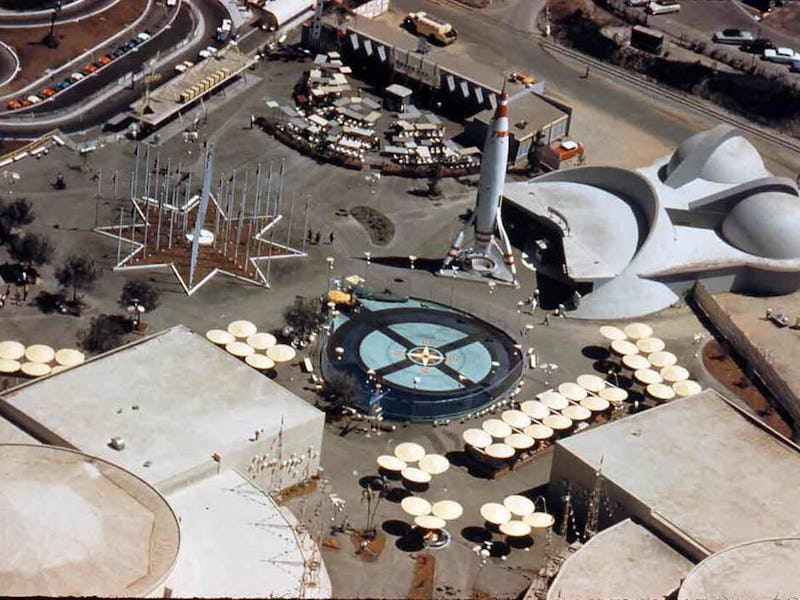Tomorrowland Was Always Corporate Propaganda Masquerading as Futurism
Walt Disney wanted to build a utopia. Instead, he built a future corporations could get behind.

Tomorrowland, the Anaheim, California theme park, is celebrating its 60th anniversary and eponymous film release this summer. Knowing Disney, it’s perhaps not so coincidental that a movie of the same name is hitting multiplexes across the world during the coveted blockbuster season at the same time.
Regardless of the quality of the movie, its storyline attempts to reboot Walt's 1955 vision of the future. It’s sentimental as all hell and that sentiment is still inscribed on a small sign in Anaheim: “Tomorrow offers new frontiers in science, adventure and ideals. The Atomic Age, the challenge of Outer Space and the hope for a peaceful, unified world.”
What that sign doesn't say is that the Atomic Age was for sale to the highest bidder.
When it opened on July 17, 1955, Tomorrowland was the last of the five planned areas of Disneyland to finish construction. At the time, it was intended to be a mockup of 1986, but the fun was somewhat undercut due to the fact that it severely lacked a crucial element to any theme park: functioning rides. That was oddly prescient (gas crisis joke!), but hardly appealing.
Early on, Autopia was one of the few operational rides, mini go-kart-like cars meant to preview interstate highways. A form of it survives in the park today. Another opening-day feature was a simple walkthrough attraction of the Nautilus submarine recently used in Disney’s adaptation of 20,000 Leagues Under the Sea.
The underwhelming, recycled Nautilus ride was no fluke. Tomorrowland lacked variety when it launched mostly because it didn’t have enough of a budget to fulfill Walt Disney’s utopian vision of a grand future. To make sure the park had things for paying guests to do on opening day, the park made deals with various companies to sponsor futuristic pavilions and attractions.
Disney himself wasn’t too keen on the idea, but he caved because of the park's costs. In the 1987 book Disneyland: Inside Story, former Imagineer Randy Bright explained, “Walt had been forced to accept several corporate county-fair-type exhibits to populate the buildings. The Monsanto ‘Hall of Chemistry,’ the Dutch Boy Paints ‘Color Gallery,’ and Kaiser’s ‘Hall of Aluminum Fame’ did little more than promote the companies themselves, and even less to promote the future.”
Described in a 1955 LA Times article as a place that “shows you the romance of chemistry, how chemically-made products benefit your life, how they can make a new and startling world tomorrow,” Monsanto’s Hall of Chemistry was anchored by something called the “Chematron,” which was a system of eight gigantic tubes that showed guests common substances in nature that also conveniently made up 500 different Monsanto products. Monsanto would also open its “House of the Future” two years after opening day in an attraction that featured an ultra-modern home with new housewares like microwaves and plastic furniture, presaging a future that in fact belongs to Ikea.
Dutch Boy Paint’s Color Gallery, which actually sounds kind of fun, featured rearrangeable color wheels all tied to different hues of paint, while Kaiser’s Aluminum Hall of Fame was exactly as exciting as it sounds. The walkthrough exhibit was basically a showroom for the company's line of aluminum products, and featured a 40-foot aluminum telescope and a massive aluminum ball called the “Time Sphere” meant to suggest that the metal would be the foundation of the products of the future.
The cornerstone of Tomorrowland’s corporate shilling was the TWA Moonliner, an 80-foot-tall model of a rocketship emblazoned with the company’s three-letter logo. The structure was co-designed by infamous aerospace engineer Wernher von Braun and was meant to resemble the equally infamous V-2 rocket. It was also taller than Sleeping Beauty’s Castle in the nearby Magic Kingdom. The focal point of the original Tomorrowland stood outside the park’s Rocket to the Moon ride until it was rebranded with a new sponsor, Douglas Aircraft, in 1962.
The sponsorships didn’t stop there. The Alweg monorail was added in 1959, the Bell Systems/Pacific Telephone Circarama (sort of a forerunner to an IMAX theater) was added in 1960, while a complete revamping of the area into the “New Tomorrowland” in 1967 brought with it GE’s Carousel of Progress, the Goodyear People Mover, Coca-Cola’s Tomorrowland Terrace, and yet another Monsanto pavilion called the Adventure Thru Inner Space.
Disney cooked its propaganda-for-pay into a self-feeding cycle. A Magic Kingdom movie has been in the works for a while, and may be completed in the next few years. But it all started with an ambitious look towards the future. What Disney wanted was an idyll: “new frontiers in science, adventure and ideals.” He managed to get a version of that with companies and their checkbooks in tow.